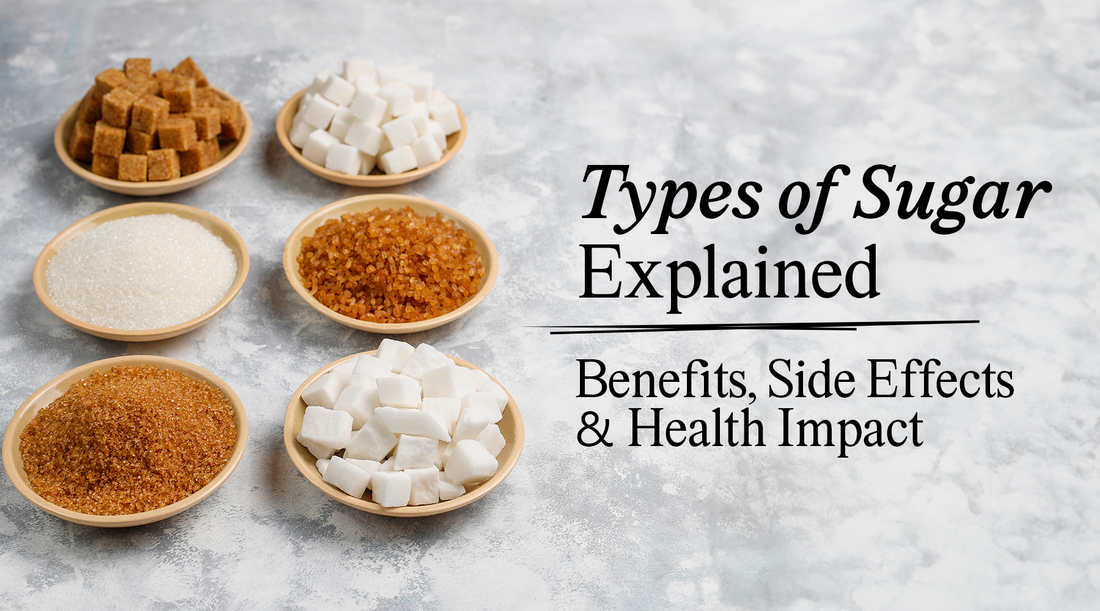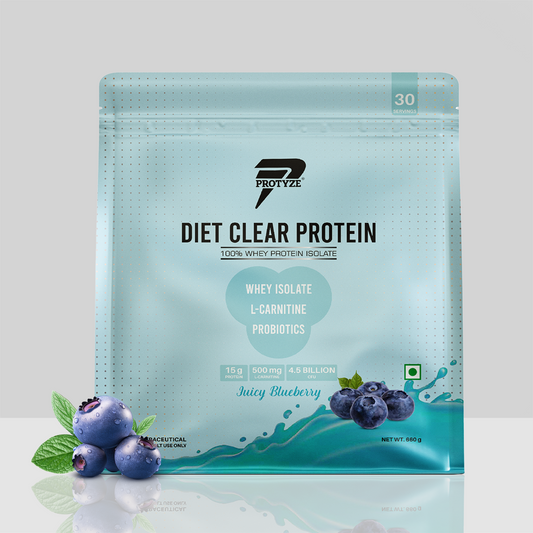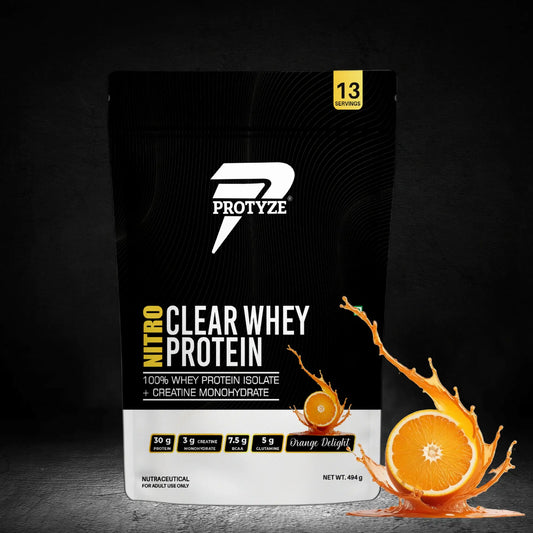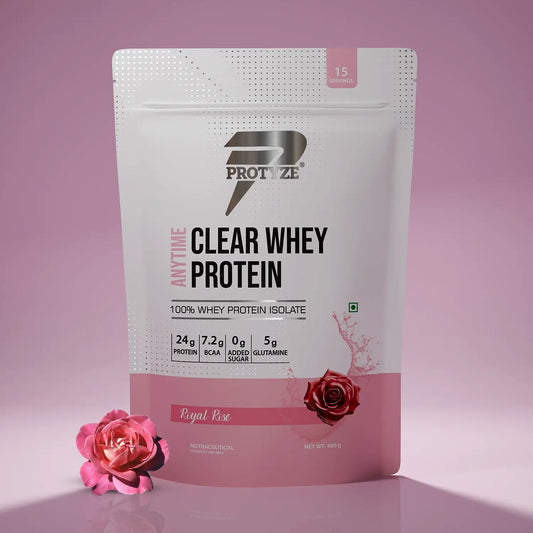Sugar is everywhere — from desserts and soft drinks to fruits and everyday meals. While it boosts energy and makes food taste delicious, not all sugars are the same. Some are natural and healthier, while others can harm your body when consumed in excess. Understanding the types of sugar, their pros and cons, and how they affect your health can help you make smarter choices. In this article, we’ll break it down simply — plus show you why a clean option like Protyze Clear Whey Protein (with zero added sugar) is a smarter way to fuel your body
What Is Sugar?
Sugar is a type of carbohydrate that your body uses for energy. It comes in many forms and is found in foods like fruits, vegetables, and honey. It’s also added to things like candy, soda, and baked goods. When you eat sugar, your body turns it into glucose, which gives you energy to move, think, and stay active. But not all sugars are the same, and eating too much can lead to weight gain or other health issues. Let’s explore the different types.
Types of Sugar
There are two main groups of sugar: natural sugars and added sugars. Within these, there are different kinds. Here’s a simple breakdown:
1. Natural Sugars
These sugars are found in whole foods and come with other nutrients.
-
Fructose: This is the sugar in fruits and honey. It’s sweet and gives you a quick energy boost.
-
Lactose: This is the sugar in milk and dairy products. It’s less sweet and helps with calcium absorption.
-
Glucose: Found in some fruits and vegetables, this is the main sugar your body uses for energy.
- Maltose: This is in some grains like barley and gives a mild sweetness.
2. Added Sugars
These are sugars put into food and drinks during processing or cooking.
-
Sucrose (Table Sugar): Made from sugarcane or beets, this is the white sugar you use at home. It’s half glucose and half fructose.
-
High-Fructose Corn Syrup (HFCS): A common sweetener in sodas and processed foods, made from corn. It has more fructose than sucrose.
-
Brown Sugar: Sucrose with molasses added for color and flavor. It’s often used in baking.
-
Cane Sugar: A less processed form of sucrose, sometimes called raw sugar.
-
Invert Sugar: A mix of glucose and fructose, used to keep foods moist, like in jams.
-
Maple Syrup: A natural sweetener from tree sap, with some minerals but mostly sugar.
-
Agave Nectar: From the agave plant, it’s sweeter than sugar and often used as a “healthy” option.
- Coconut Sugar: Made from coconut palm sap, it has a caramel taste and some nutrients.
These sugars can be found in many foods, from natural sources like apples to added ones like cookies.
Advantages of Different Types of Sugar
Each type of sugar has some good points, depending on how you use it:
Advantages of Natural Sugars
-
Fructose: Gives quick energy and comes with fiber and vitamins from fruits, which help your digestion.
-
Lactose: Helps your body absorb calcium and keeps bones strong, especially in milk.
-
Glucose: Provides fast energy for your brain and muscles, great for active people.
- Maltose: Adds a mild sweetness to grains and supports energy needs.
Advantages of Added Sugars
-
Sucrose: Easy to use in cooking and baking, making food tasty and enjoyable.
-
High-Fructose Corn Syrup: Cheap and keeps foods like sodas sweet and shelf-stable.
-
Brown Sugar: Adds flavor and moisture to recipes, like in cookies or cakes.
-
Cane Sugar: Less processed than white sugar, with a slight nutrient edge.
-
Invert Sugar: Keeps baked goods soft and prevents sugar crystals.
-
Maple Syrup: Has small amounts of minerals like manganese and zinc.
-
Agave Nectar: Sweeter than sugar, so you can use less, and it’s plant-based.
- Coconut Sugar: Contains some fiber and antioxidants, making it a bit healthier than white sugar.
These advantages make sugar useful, especially when eaten in small amounts or from natural sources.
Disadvantages of Different Types of Sugar
While sugar has benefits, it also has downsides, especially if you eat too much:
Disadvantages of Natural Sugars
-
Fructose: Too much, especially from processed foods, can strain your liver and lead to fat buildup.
-
Lactose: Some people can’t digest it (lactose intolerance), causing bloating or stomach pain.
-
Glucose: Eating too much can spike blood sugar, which is bad for people with diabetes.
- Maltose: Rare, but too much can still add empty calories.
Disadvantages of Added Sugars
-
Sucrose: Adds extra calories without nutrients, leading to weight gain if overeaten.
-
High-Fructose Corn Syrup: Linked to obesity, heart disease, and liver problems because of high fructose levels.
-
Brown Sugar: Still high in calories and can raise blood sugar quickly, despite the molasses.
-
Cane Sugar: Similar to sucrose, with little nutritional value.
-
Invert Sugar: Can contribute to tooth decay and weight gain if overused.
-
Maple Syrup: High in sugar, so it’s not a health food despite minerals.
-
Agave Nectar: Very high in fructose, which can harm your liver if eaten a lot.
- Coconut Sugar: Still mostly sugar, so it doesn’t solve the problem of excess calories.
The main issue with added sugars is that they often come in processed foods, making it easy to eat too much without noticing.
How Sugar Affects Your Body
Sugar gives you energy, but how it affects you depends on the type and amount:
-
Energy Boost: All sugars turn into glucose, giving you energy for daily tasks or workouts.
-
Blood Sugar Spikes: Added sugars like sucrose can raise blood sugar fast, while natural sugars with fiber (like in fruits) are slower.
-
Weight Gain: Too much sugar, especially from sodas or candy, adds calories without filling you up.
-
Dental Health: Sugars feed bacteria in your mouth, leading to cavities.
- Long-Term Risks: Over time, too much sugar can increase the risk of diabetes, heart disease, and fatty liver.
Eating sugar in moderation from natural sources is better than loading up on added sugars.
Natural Sugars vs Added Sugars: What’s the Difference?
-
Natural Sugars: Found in whole foods like fruits (fructose) and milk (lactose). They come with fiber, vitamins, and minerals, which slow down sugar absorption and add health benefits.
- Added Sugars: Put into foods during processing, like in cookies or drinks (sucrose, HFCS). They add calories but no extra nutrients, making them less healthy.
For example, an apple has natural fructose with fiber, while a soda has added sugar with no benefits. Choosing natural sugars helps you avoid the disadvantages of added ones.
How Much Sugar Is Okay?
The amount of sugar you should eat depends on your needs:
-
Daily Limit: Health experts suggest keeping added sugars to less than 10% of your daily calories. For a 2,000-calorie diet, that’s about 50 grams (12 teaspoons).
-
Natural Sugars: There’s no strict limit, but eating whole fruits and dairy in balance is fine.
- Fitness Goals: If you’re active, you can handle more sugar for energy, but avoid added kinds.
Reading food labels can help you spot added sugars and stay within limits.
Smart Ways to Use Sugar
You don’t have to avoid sugar completely—here are some tips:
-
Choose Natural Sources: Eat fruits, vegetables, and milk for sugar with nutrients.
-
Limit Added Sugars: Cut back on sodas, candies, and processed snacks.
-
Balance with Protein: Pair sugar with protein to slow sugar spikes. For example, mix a little fruit with Protyze Clear Whey Protein (no added sugar) for a healthy shake.
-
Cook at Home: Use small amounts of maple syrup or honey instead of table sugar.
- Watch Portions: Enjoy sweets occasionally, not every day.
Sugar and Fitness
If you work out, sugar can play a role:
-
Energy: Glucose from sugar fuels your muscles during exercise.
-
Recovery: Some sugars help replenish energy stores after a workout.
- Avoid Excess: Too much added sugar can lead to fat gain, so focus on natural sources.
For a sugar-free protein boost, Protyze Clear Whey Protein offers protein with probiotics and L-carnitine, supporting weight management without the downsides of sugar.
Potential Downsides of Too Much Sugar
Eating too much sugar, especially added types, can cause:
-
Weight Gain: Extra calories turn into fat if not burned.
-
Diabetes Risk: High sugar intake can make your body less sensitive to insulin.
-
Heart Problems: Too much can raise cholesterol and blood pressure.
-
Tooth Decay: Sugar feeds harmful bacteria in your mouth.
- Energy Crashes: Quick sugar highs lead to low energy later.
Keeping sugar in check helps you stay healthy and fit.
Final Thoughts
Sugar is a part of life, but knowing the types of sugar and their advantages and disadvantages can help you make smart choices. Natural sugars from fruits and milk give you energy and nutrients, while added sugars like sucrose and HFCS can cause problems if you eat too much. The key is balance—enjoy natural sugars and limit added ones. If you’re watching your sugar intake while building strength or managing weight, Protyze Clear Whey Protein is a great option with no added sugar, and a light, refreshing taste. By choosing wisely, you can enjoy the benefits of sugar without the downsides and keep your health on track!





